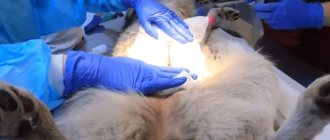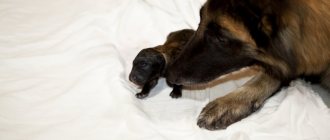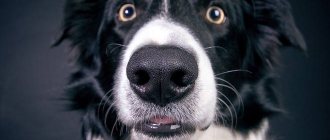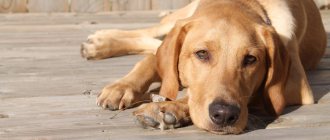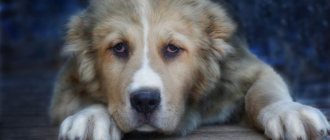Veronica Igorevna Sharipova
veterinarian Petstory
In the modern world, perhaps every pet at least once in its life goes through some procedure or operation that is impossible without anesthesia. Of course, any owner is worried about this event, especially since there is a lot of conflicting information around anesthesia. So what is anesthesia, how to prepare for it and how dogs tolerate it - we will look further in our article.
- Inhalation
- The first day after anesthesia
Types of anesthesia for dogs and corresponding drugs
The choice of drug depends on the complexity of the operation. For short-term procedures, veterinarians use Propofol or Diprivan, and for biopsy and premedication - Oxymorphone. Another popular anesthetic is Rometar.
All of these drugs desensitize the patient without putting him into deep sleep. This reduces wake-up time and reduces stress on the cardiovascular system.
Due to the presence of effective anesthetics with a gentle effect on the body, the use of Ditilin and Ketamine is becoming less and less justified. These medications provoke hallucinogenic dreams, which have a detrimental effect on the psyche. For the safety of your pet, it is better to pay separately for a more reliable drug.
Anesthesia for dogs is administered intravenously, intramuscularly or by inhalation. It is also possible to use several types of anesthesia at the same time.
General
General anesthesia for dogs is used not only during surgery, but also during unpleasant procedures: teeth cleaning, endoscopy. In addition to pain relief, it helps immobilize the patient, making the work of the surgeon or veterinary therapist easier.
Intravenous administration is safer than intramuscular administration. The substance quickly spreads throughout the body, causing drug-induced sleep within a minute. It is easier for the anesthesiologist to track the amount of drug administered without causing complications.
The disadvantages of general anesthesia include:
- decrease in heart rate;
- likelihood of prolonged respiratory depression;
- decrease in blood pressure.
It takes several hours for the animal to fully recover. To avoid consequences, the dog is left in the hospital until it fully awakens.
Local
An easier anesthesia for dogs is local. According to the technique of execution, it can be:
- Superficial
. Used for manipulations in the oral cavity. Allows you to anesthetize mucous membranes by freezing their sensitivity.
- Infiltration
. Involves applying medication around the affected area, making it easier to remove teeth, open abscesses, and stitch up small bite wounds.
- Provodnikov
. An anesthetic substance is injected into the tissue located next to the nerve. This prevents the passage of nerve impulses, providing complete pain relief to dependent organs and tissues. It is carried out strictly under sedation, since any unnecessary movement can lead to damage to the nerve endings. Effective for rib fractures, removal of reproductive organs, bladder surgeries and even amputations.
Despite the relatively low danger, it is best to use the gas type. It involves administering the substance directly through the lungs, which prevents its settling in the internal organs.
Gas
Gas or inhalation anesthesia for dogs is recommended for patients with liver and kidney diseases. The drug is administered through a special mask or endotracheal tube.
In addition to ease of use, the gas type is attractive due to the absence of side effects and the rapid speed of awakening. The animal comes to its senses a couple of minutes after the procedure is completed. The only negative is the possible period of use, which is no more than 2 hours.
What should alert the owner
The way a dog behaves after anesthesia indicates how easy the recovery period is for it. The owner should be wary of the following points:
- The dog is breathing heavily after anesthesia, wheezing, coughing. A complication may occur if the pet has problems with the respiratory and cardiovascular systems.
- Irritation, allergies, and swelling occurred at the operation site. It may be necessary to replace the antiseptic, medications, or prescribe antihistamines.
- Constipation, lack of urination 2-3 days after surgery. The pet must be urgently shown to the veterinarian and the feeding changed.
- The dog vomits after anesthesia for several days.
When is anesthesia necessary?
The main task of anesthesia is not pain relief at all - analgesics cope with this problem. Despite the absence of pain, a four-legged patient is unlikely to tolerate drilling a tooth or interfering with its internal organs. Fear makes the behavior of animals completely unpredictable, so doctors try to limit their activity for mutual safety. Therefore, anesthesia sleep is immobilization, not pain relief.
The main indications for the use of anesthetics include:
- surgeries on limbs and internal organs;
- unpleasant cosmetic and diagnostic procedures;
- severe stress or uncontrolled aggression on the part of the patient.
Additionally, muscle relaxants are introduced into the body to relax the muscles. Throughout all manipulations, the state of the body is monitored by special sensors that trigger ventilation in an emergency.
Preparing the animal
The main cause of complications in the postoperative period is a sharp drop in immunity. For a comfortable recovery, it is recommended to take care of protecting your pet in advance, preventing possible troubles.
Home preparations
To prevent infection by parasites, the animal is treated for worms 1.5 weeks before surgery. Timely vaccination provides protection against viral infections. At least a month must pass from the date of its implementation. Otherwise, the body will not have time to form an immune response. In this case, it is recommended to use a serum injection, which gives a similar result within 2 weeks.
Avoid feeding completely 12 hours before surgery. The bowl of water will have to be removed a little later - 3 hours before. Neglecting these recommendations may result in aspiration pneumonia due to an attack of vomiting.
Tests and examination at the veterinary clinic
When examined in a veterinary clinic, it is important to determine how harmful the use of an anesthetic is. This depends on the degree of anesthetic risk.
Animals with grade 5 are especially difficult to tolerate manipulations. This group includes patients with advanced pathologies and contraindications, so the owner must be warned about all possible risks. Surgeons try to avoid such surgical intervention if the likelihood of a positive outcome is close to zero.
A couple of days before the procedure, a blood test is taken from the animal. He gets an X-ray, ultrasound and electrocardiogram. The results obtained help to assess possible risks and select a safe dosage.
Preoperative period
He should never be underestimated. Any surgical intervention, whether planned or emergency surgery (procedure), carries certain risks to the life and health of the animal. This is due to the fact that operations and some procedures (manipulations) are performed under general anesthesia (anesthesia). The success of surgery and subsequent recovery directly depends on the preoperative preparation of the pet. During this period, the doctor draws up a general picture of the animal’s condition, determines the severity of the underlying disease and the presence of concomitant disorders (for example, cardiac ones). To minimize risks, the necessary examinations are carried out, and sometimes additional therapy is prescribed.
For healthy animals up to 7 years old
Elective surgeries (for example, spay and neuter) or procedures under anesthesia (ultrasound teeth cleaning, x-rays under sedation) are most often performed without additional examinations of pets. But only if they are under seven years of age and do not have a breed predisposition to heart disease. Such operations are prescribed without first seeing a therapist, and you can sign up for them simply by calling.
For animals over 7 years old or with a history of diseases
Pets in this age category must first see a therapist. This also applies to animals with any diseases (for example, chronic kidney disease or acute liver failure). And in the case of tumor processes, you should make an appointment with an oncologist and surgeon in advance. For such animals, the day of surgery is assigned only after all the necessary examinations.
They must:
- General and biochemical blood test. A general blood test shows the level of leukocytes, red blood (to exclude anemia), and the number of platelets.
- Biochemistry
. It is necessary to assess the functionality of the kidneys and liver in older animals (over 7 years old), since many diseases of the liver, kidneys and heart can occur chronically, without clinical signs and symptoms, and during surgery they can lead to complications and even death of the animal.
Additional tests ordered for some animals
Radiography
It is necessarily carried out to exclude lung pathology, if tumor metastasis is suspected, etc.
Ultrasound
The study is carried out to visually assess the abdominal organs. It is prescribed for suspected presence of free fluid in the chest or abdominal cavity, before cesarean section (including calculating the fetal heart rate), suspected tumor metastases or ruptures of abdominal organs, etc.
Cardiac research
An electrocardiogram (ECG) should be performed on older animals with a history of loss of consciousness, chronic cough, and periodically blue mucous membranes and tongue. It will help identify disturbances in the rhythm and conduction of the heart, as well as a lot of indirect signs of disturbances in the functioning of the heart and its structure.
ECHO of the heart is used to determine the size of the chambers and muscles of the heart, to assess the function and structure of the valves, to detect regurgitation (backflow of blood), etc. It is necessarily carried out in purebred cats to exclude hereditary pathology - hypertrophic cardiomyopathy (HCM). All necessary tests can be completed in one or several days.
After examination and research, you can:
- draw conclusions about the need for surgical intervention (or performing one or another manipulation under anesthesia);
- set the time and date of the operation;
- carry out preoperative therapy in cases of abnormal test results.
It is very important that the animal is as stable as possible before anesthesia.
If the tests are good, surgery is scheduled for the near future.
If the operation is emergency, tests are prescribed individually in each case, taking into account the condition of the animal.
At home the day before surgery
Before surgery, a fasting diet is required:
- for cats – 3–4 hours;
- for dogs – 4–6 hours, except for brachycephalic breeds (with a flat muzzle) – a fast of at least 8–10 hours is recommended for them;
- for puppies and kittens aged 1–6 months - fasting for no more than 4 hours;
- if surgery is planned for interventions on the gastrointestinal tract, gastroduodenoscopy - fasting for 10-12 hours.
The only exception is newborns (up to four weeks of age), they are delivered to the clinic together with nursing mothers.
The countdown is from the beginning of the operation, and not from the moment the animal arrives at the clinic.
For the specified period, absolutely any food should be excluded, and water should not be given 1 hour before the operation. This is due to the fact that when the animal is given sedation or anesthesia, vomiting of feed may occur. If this happens, there is a risk of developing aspiration pneumonia. Therefore, a fasting diet is extremely important.
In the clinic on the day of surgery
On the appointed day, immediately before the operation, the necessary information is collected and the animal is thoroughly examined by an anesthesiologist. Next, the patient is taken to the hospital for the necessary surgical intervention. Pedigree cats undergo cardiac ECHO on the same day (or in advance). After consultations with the anesthesiologist, the pet's owners sign a written consent to give the animal anesthesia and deposit the necessary funds into the balance. The owners' participation is no longer required at this stage; they can leave the clinic.
Stages of entering anesthesia
In case of complex surgery or severe stress, premedication is administered 10-15 minutes before anesthesia. This preparatory procedure relaxes the patient using intravenous or intramuscular sedatives. Additionally, medications are administered to prevent cardiac arrest.
An intravenous catheter is placed in the animal to administer the anesthetic. On average, it takes 10-30 minutes to fall asleep completely. Free access of oxygen is ensured by tracheal intubation. Pain is relieved with analgesics. The patient is connected to sensors that monitor breathing rate and heart rate.
Depending on the dosage and type of anesthesia, the animal loses mobility for 1-3 hours. For most operations, this time is quite enough, so additional injection of anesthetic drugs is practically not used.
First day after surgery
The veterinarian must tell the owners how long and exactly how the dog recovers from anesthesia after sterilization, castration or other surgery. This facilitates subsequent recovery and helps to identify possible deviations in a timely manner.
Behavior: how dogs recover from anesthesia
Most often, doctors give the animal away strictly after waking up. Until this time, he is kept in the hospital in order to promptly help in case of complications.
When sleep is introduced, all body functions slow down. Due to the low body temperature, severe chills occur. Prepare a warm blanket in advance to warm your pet on the way back. Upon arrival home, do not use heating pads or heating devices - they can cause inflammation.
In addition to trembling and severe weakness, the dog’s breathing is temporarily impaired. On the first day you will have to monitor the frequency of your breaths.
Depending on the type of anesthesia, temporary failure of the hind legs and loss of coordination are allowed. Place the operated animal on the floor and do not allow it to jump on high objects. Try not to leave your pet, waiting until he fully comes to his senses. Due to limited mobility, the dog will be very scared and may injure himself.
Don't be alarmed by sudden mood swings. Many pets hide their fear in redirected aggression. Do not bother with your attention, but try to calm the animal if necessary.
Malaise within normal limits
Don't be alarmed if your dog shakes and vomits after anesthesia. Shivering helps keep you warm, and a single attack of nausea soon improves your overall health.
Aggressive and fearful behavior may persist until coordination returns. Get ready for the animal to stagger, roll over on its side, twitch its paws, whine, or simply not move.
If you have no appetite, do not try to force feed your pet. A fasting diet for 24 hours will do him good.
What should you be wary of?
The duration of illness varies from person to person, but should not exceed a day. If symptoms persist the next day, be sure to consult a doctor. Alarming symptoms also include:
- the appearance of bleeding;
- suture dehiscence or suppuration;
- blueness of mucous membranes;
- two days of hyperthermia or vomiting;
- weak intermittent breathing;
- shortness of breath, cough and wheezing.
If your pet is constantly coughing or has swelling in the operated area, rush for help. Impaired respiratory function and acute inflammation can be fatal.
Warning symptoms
Usually any ailments go away within 24 hours. If symptoms persist for a longer period of time, take your pet to the clinic. Among the warning signs are:
- bleeding;
- opening of a suture or the appearance of pus in the wound;
- cyanosis of mucous membranes;
- high fever, nausea;
- frequent shallow breathing;
- shortness of breath, cough, wheezing.
An alarming symptom if swelling appears at the wound site. Respiratory disorders and inflammatory processes often lead to the death of the animal.
Care and feeding in the following days
The duration of the recovery period is individual and determined by the doctor. To care for your operated pet you will need:
- Prepare a warm place, protected from noise and drafts. Keep children and other pets away from the animal until it comes to its senses.
- Temporary diet. You can give your dog water 4 hours after he wakes up, by wetting his lips with a damp cloth or giving the liquid directly from a syringe. It is better to feed only every other day. Food should be light and soft. Wet canned food, pieces of spider meat, or broths with watery porridges are suitable.
- Place absorbent diapers under the bed and change the sleeping place regularly. In the first days, the animal has poor control over the urge to defecate and the bladder.
- Avoid walking outside for 2 weeks. Compliance with quarantine is especially important for a puppy who does not have immunity against viruses.
In most cases, wounds heal within 10 days. During this time, a protective collar is put on the animal to prevent damage and contamination of the seams. Protect the wound from getting wet, which inhibits tissue repair. Remember that all ointments are used only as prescribed by a doctor.
Seam processing
The discomfort of sutures after surgery varies between males and females. Caring for a male dog after castration does not require as much effort as the rehabilitation of a female dog. Some surgeons prescribe pain medications right away, others only as needed.
The acceptance of such funds is due to the following:
- the owner knows that his dog cannot tolerate pain, the specialist should be notified about this immediately;
- The dog owner sees that the rehabilitation period is complicated by severe pain. For example, during defecation, the dog whines, moves with extreme caution and cannot make sudden movements.
The use of painkillers can greatly speed up the recovery process, then the dog will not damage the suture with its teeth, and will also move normally without resting. Many specialists immediately prescribe a course of antibiotics to prevent the occurrence of an inflammatory process.
Whether the seam needs to be treated after it has been applied depends on:
- the material of the seams themselves;
- method of its application;
- method of treatment after surgery.
In each case, the drugs will be prescribed or not prescribed by the doctor. If the doctor says that there is no need to treat the suture, and you notice inflammation, swelling or redness in this area, make an appointment with a veterinarian.
After sterilization, the seam should be dry, without redness, crusts or other growths. With normal healing, the appearance of the seam will become better and better every day.
The need for blankets
To protect the seam from bacteria and mechanical damage, the dog will need a blanket. In modern clinics, a blanket is put on the dog immediately after surgery. One copy will not be enough, because the thin material quickly gets wet and dirty. The bandage should be changed once a day and be sure to pet it before putting it on your dog. When processing seams, you should not remove the blanket; you can only untie a couple of ribbons and move the material to the side.
If the dog constantly strives to take off the blanket, put an Elizabethan collar on it or constantly monitor it so that it still does not manage to touch it. To prevent the seam from unraveling, make sure that the dog does not play outdoor games or jump; it is better to give preference to light and quiet walks. If it is difficult for your dog to climb stairs, then it is better to set up a toilet at home for the first few days.
Whether suture removal is necessary will depend on the suture material and how it was placed. In some cases, removal of sutures is not required, because the threads will dissolve and dry out on their own. The veterinarian will tell you whether the suture needs to be removed and when it needs to be done. On average, sutures are removed 2 weeks after the operation.
Negative effects of anesthetics
Thanks to the advent of drugs with a gentle effect, the harm from anesthesia is minimized. With the correct dosage and strict adherence to the preparatory steps, no side effects are observed.
Harm to internal organs
In the gas form, harm to internal organs is excluded, since foreign substances are eliminated from the body during breathing. Unpleasant consequences are possible only if there are contraindications. In such cases, the use of anesthetics is permissible only when the possible risks are less than the existing threat.
Contraindications
The use of anesthetic drugs is not recommended in the presence of factors that weaken the body. These include:
- estrus, pregnancy and lactation;
- acute viral infections and chronic diseases of the genitourinary system;
- pathologies of the cardiovascular and respiratory systems;
- old age of more than 10 years.
If the situation involves neglecting the recommendations, the veterinarian must warn about possible complications and risks. In such cases, surgical intervention is carried out strictly after the written consent of the owner.
Possible complications and risks
Dangerous complications after anesthesia in dogs rarely occur. Most of them are short-lived and are common side effects.
Pulmonary or cerebral edema
This complication occurs due to circulatory problems. It is typical for severely weakened animals with a high degree of anesthetic risk.
Heart rhythm disturbance
A temporary decrease in heart rate and slowing of breathing is not dangerous, but requires monitoring. Particular attention should be paid to owners of pugs, spaniels and bulldogs. Representatives of these breeds often experience stroke after surgery.
Trembling and loss of coordination, seizures
The dog trembles strongly after anesthesia only for the first day, until its thermoregulation returns to normal. The owner simply needs to monitor the temperature change using a thermometer.
Problems with coordination are explained by suppression of muscle activity. She also recovers on her own after a few days.
Only convulsions that indicate damage to the central nervous system are truly dangerous. If they appear, you must immediately contact your veterinarian.
Allergic reaction
Allergies to the main components of the drug cannot be predicted before its use. Because of this, it is recommended to leave the animal for several hours in the hospital under the supervision of doctors.
